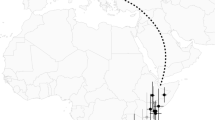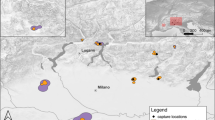Abstract
Quantitative magnetic resonance (QMR) is a non-invasive technology used to measure body composition. It has great potential to advance the study of energetics and fuel use of migratory birds. However, there is concern that exposure to a strong magnetic field during QMR analysis could affect magnetite-based geomagnetic senses of migratory songbirds which may be important for orientation and navigation. We used radiotelemetry and capture-mark-recapture analysis to test for effects of QMR analysis on stopover duration and departure orientation. There was no evidence from radiotelemetry data that QMR analysis influenced minimum stopover duration or departure orientation of Black-throated Blue Warblers (Setophaga caerulescens) in the spring or fall, or Magnolia Warblers (Setophaga magnolia) in the spring. Capture-mark-recapture analysis of White-throated Sparrow (Zonotrichia albicollis) ringing data showed no effects of QMR on transiency or recapture probability, but a slight increase in estimated stopover duration (days) in the fall. Our study provides evidence that stopover duration and departure orientation of migrating songbirds are not significantly affected by QMR analysis with the exception of fall stopover duration estimates from mark-recapture models, and that QMR is a safe technique for the study of birds in the field.
Zusammenfassung
Ein Freilandtest zur Prüfung möglicher Auswirkungen der Quantitative Magnetresonanztomographie (QMRT) zu Bestimmung der Körperzusammensetzung auf das Verhalten von Zugvögeln während ihrer Rast
Quantitative Magnetresonanztomographie (QMRT) ist eine nicht-invasive Methode zur Messung von Körperzusammensetzungen. Sie hat ein großes Potential, Untersuchungen zu Energetik und „Treibstoff“-Nutzung von Zugvögeln voranzubringen. Es gibt jedoch Bedenken, ob das starke Magnetfeld während der QMRT-Analyse Auswirkungen auf den auf Magnetit basierenden und für Orientierung und Navigation wichtigen Magnetsinn der Zugvögel haben könnte. Wir benutzten Radiotelemetrie und Wiederfänge beringter Vögel, um die QMRT-Analyse auf mögliche Effekte auf Rastdauer und auf die Orientierung beim Abflug zu testen. Die Radiotelemetrie ergab keinerlei Nachweise dafür, dass sich die QMRT-Analyse auf die kurze Dauer eines Zwischenstopps oder auf die Orientierung beim Abflug auswirkte. Getestet wurde dies für den Blaurücken-Waldsänger (Setophaga caerulescens) im Frühjahr und im Herbst und für den Magnolien-Waldsänger (Setophaga magnolia) im Frühjahr. Fang-Wiederfang-Analysen bei Weißkehlammern (Zonotrichia albicollis) zeigten keine Effekte der QMRT auf Durchzug und Wiederfang-Wahrscheinlichkeit, aber einen leichten Anstieg der Rastdauer (in Tagen) während des Herbstzugs. Unsere Untersuchung belegt, dass durch eine QMRT-Analyse weder die Rastdauer noch die Orientierung beim Abflug von Zugvögeln signifikant beeinflusst sind, ausgenommen der anhand von Wiederfang-Modellen geschätzten Rastdauer im Herbst. QMRT zeigt sich als eine sichere Methode für Freilanduntersuchungen.



Similar content being viewed by others
References
Åkesson S, Backman J (1999) Orientation in Pied Flycatchers: the importance of magnetic and visual information at dusk. Anim Behav 57:819–828
Anderson DR, Burnham KP (2002) Avoiding pitfalls when using information-theoretic methods. J Wildl Manag 66:912–918
Bächler E, Schaub M (2007) The effects of permanent local emigration and encounter technique on stopover duration estimates as revealed by telemetry and mark-recapture. Condor 109:142–152
Beason RC (2005) Mechanisms of magnetic orientation in birds. Integr Comp Biol 45(3):565–573
Blakemore R (1975) Magnetotactic bacteria. Science 190(4212):377–379
Blakemore R, Frankel R, Kalmijn AD (1980) South-seeking magnetotactic bacteria in the southern hemisphere. Nature 286:384–385
Bonter D, Brooks E, Donovan T (2008) What are we missing with only ground-level mist nets? Using elevated mist nets at a migration stopover site. J Field Ornithol 79:314–320
Caccamise D, Hedin R (1985) An aerodynamic basis for selecting transmitter loads in birds. Wilson Bull 97(3):306–318
Cochran W, Mouritsen H, Wikelski M (2004) Migrating songbirds recalibrate their magnetic compass daily from twilight cues. Science 304:405–408
Cooch E, White G (2001) Program MARK: a gentle introduction manual. Cornell University, Ithaca
Calvert AM, Bonner SJ, Jonsen ID, Mills Flemming J, Walde SJ, Taylor PD (2009) A hierarchical Bayesian approach to multi-state mark-recapture: simulations and applications. J Appl Ecol 46(3):610–620
Davila AF, Winklhofer M, Shcherbakov VP, Peterson N (2005) Magnetic pulse affects a putative magnetoreceptor mechanism. Biophys J 89(1):56–63
Fleissner G, Holtkamp-Rötzler E, Hanzlik M, Winklhofer M, Fleissner G, Petersen N, Wiltschko W (2003) Ultrastructural analysis of putative magnetoreceptor in the beak of homing pigeons. J Comp Neurol 458:350–360
Fransson T, Jakobsson S, Johansson P, Kullberg C, Lind J, Vallin A (2001) Magnetic cues trigger extensive refuelling. Nature 414:35–36
Goymann W, Spina F, Ferri A, Fusani L (2010) Body fat influences departure from stopover sites in migratory birds: evidence from whole-island telemetry. Biol Lett 6(4):478-481
Guglielmo C, McGuire L, Gerson A, Seewagen C (2011) Simple, rapid and non-invasive measurement of fat, lean and total water masses of live birds using quantitative magnetic resonance. J Ornithol. doi:10.1007/s10336-011-0724-z
Hedenstrom A, Alerstam T (1997) Optimum fuel loads in migratory birds: distinguishing between time and energy minimization. J Theor Biol 189:227–234
Heise C, Moore F (2003) Age-related differences in foraging efficiency, molt and fat deposition of gray catbirds prior to autumn migration. Condor 105:496–504
Henshaw I, Fransson T, Jakobsson S, Kullberg C (2010) Geomagnetic field affects migratory direction in long distant migrant. Behav Ecol Sociobiol 64:1317–1323
Holland R (2010) Differential effects of magnetic pulses on the orientation of naturally migrating birds. J R Soc Interface 7:1617–1625
Holland R, Helm B (2013) A strong magnetic pulse affects the precision of departure direction of naturally migrating adult but not juvenile birds. J R Soc Interface 10(81):20121047
Lebreton J, Pradel R (2002) Multistate recapture models: modelling incomplete individual histories. J Appl Stat 29:353–369
Lindberg MS (2010) A review of designs for capture-mark-recapture studies in discrete time. J Ornithol. doi:10.1007/s10336-010-0533-9
Lindberg MS, Rexstad EA (2002) Capture-recapture sampling designs. In: El-Shaarawi AH, Piegorsch WW (eds) Encyclopedia of environmetrics, 1st edn. Wiley, Chichester, pp 251–262
Mackenzie S (2010) A scale-dependent examination of stopover decisions in migratory passerines at Long Point, Ontario. M.Sc. dissertation, University of Western Ontario
Marchetti K, Price T (1989) Differences in the foraging of juvenile and adult birds: the importance of developmental constraints. Biol Rev 64:51–70
Matthews SN, Rodewald PG (2010) Urban forest patches and stopover duration of migratory Swainson’s Thrushes. Condor 112(1):96–104
McGuire LP, Guglielmo CG, Mackenzie SA, Taylor PD (2012) Migratory stopover in the long-distance migrant Silver-haired Bat, Lasionycteris noctivagans. J An. Ecol 81:377–385
Mills AM (2016) Banding data reveal bias in age-class sampling of songbirds during spring migration. J Field Ornithol. doi:10.1111/jofo.12156
Mills AM, Thurber BG, Mackenzie SA, Taylor PD (2011) Passerines use nocturnal flights for landscape-scale movements during migration stopover. Condor 113(3):597–607
Mouritsen H, Ritz T (2005) Magnetoreception and its use in bird navigation. Curr Opin Neurobiol 15(4):406–414
Muheim R, Bäckman J, Åkesson S (2002) Magnetic compass orientation in European robins is dependent on both wavelength and intensity of light. J Exp Biol 205(24):3845–3856
Muheim R, Phillips J, Åkesson S (2006) Polarized light cues underlie compass calibration in migratory songbirds. Science 313:837–839
Muheim R, Åkesson S, Phillips JB (2007) Magnetic compass of migratory Savannah sparrows is calibrated by skylight polarization at sunrise and sunset. J Ornithol 148(S2):485-494
Munro U, Munro JA, Phillips JA, Wiltschko W (1997) Effect of wavelength of light and pulse magnetization on different magnetoreception systems in a migratory bird. Aust J Zool 45(2):189–198
Newton I (2008) The ecology of bird migration. Academic, London
Nilsson C, Klassen RHG, Alerstam T (2013) Differences in speed and duration of bird migration between spring and autumn. Am Nat 181:837–845
Pyle P, Howell SN, David FY (1997) Identification guide to North American birds (No. C/598.297 P9)
Rappole J, Tipton A (1991) New harness design for attachment of radio transmitters to small passerines (Nuevo Diseñode Arnés para Atar Transmisores a Passeriformes Pequeños). J Field Ornithol 62(3):335–337
Salewski V, Schaub M (2007) Stopover duration of Palearctic passerine migrants in the western Sahara–independent of fat stores? Ibis 149(2):223–236
Schaub M, Jenni L (2001) Stopover durations of three warbler species along their autumn migration route. Oecologia 128(2):217–227
Schaub M, Liechti F, Jenni L (2004) Departure of migrating European robins, Erithacus rubecula, from a stopover site in relation to wind and rain. Anim Behav 67:229–237
Schaub M, Pradel R, Lebreton J (2001) Migrating birds stop over longer than usually thought—an improved capture-recapture analysis. Ecol 82:852–859
Seewagen CL, Guglielmo CG (2010) Effects of fat and lean body mass on migratory landbird stopover duration. Wilson J Ornithol 122(1):82–87
Seewagen CL, Guglielmo CG (2011) Quantitative magnetic resonance analysis and a morphometric predictive model reveal lean body mass changes in migrating Nearctic-Neotropical passerines. J Comp Physiol B 181(3):413–421
Seewagen CL, Slayton EJ, Guglielmo CG (2010) Passerine migrant stopover duration and spatial behaviour at an urban stopover site. Acta Oecol 36:484–492
Simons T, Moore F, Gauthreaux S (2004) Mist netting trans-Gulf migrants at coastal stopover sites: the influence of spatial and temporal variability on capture data. Stud Avian Biol 29:135–143
Sol D, Santos D, Garcia J, Cuadrado M (1998) Competition for food in urban Pigeons: the cost of being juvenile. Condor 100(2):298–304
Taylor P, Mackenzie S, Thurber B, Calvert A, Mills A, McGuire L, Guglielmo C (2011) Landscape movements of migratory birds and bats reveal an expanded scale of stopover. PLoS One 6(11):e27054. doi:10.1371/journal.pone.0027054
Thurber B (2010) Daily flight timing and movement strategies of migration landbirds: importance of local wind patterns. M.Sc. dissertation, University of Western Ontario
Treiber CD, Salzer MC, Riegler J, Edelman N, Sugar C, Breuss M, Pichler P, Cadiou H, Saunders M, Lythgoe M, Shaw J, Keays DA (2012) Clusters of iron-rich cells in the upper beak of pigeons are macrophages not magnetosensitive neurons. Nature 484(7394):367–370
Vanderhoff E, Eason P (2007) Disparity between adult and juvenile American Robins Turdus migratorius foraging for ground invertebrates and cherry fruits. Ethol 113:1212–1218
Vanderhoff E, Eason P (2008) Comparisons between juvenile and adult American Robins foraging for mulberry fruit. Wilson J Ornithol 120:209–213
White CG, Burnham KP (1999) Program MARK: survival estimations from populations of marked animals. Bird Stud 46:120–139
Wiltschko R, Wiltschko W (1995) Magnetic orientation in animals. Zoophysiol 33:261–288
Wiltschko W, Wiltschko R (2002) Magnetic compass orientation in birds and its physiological basis. Naturwissenschaften 89(10):445–452
Wiltschko W, Ford H, Munro U, Winklhofer M, Wiltschko R (2007) Magnetite-based magnetoreception: the effect of repeated pulsing on the orientation of migratory birds. J Comp Physiol A 193:515–522
Zapka M, Heyers D, Hein C, Engels S, Schneider N, Hans J, Weiler S, Dreyer D, Kishkinev D, Wild J, Mouritsen H (2009) Visual but not trigeminal mediation of magnetic compass information in a migratory bird. Nat 461:1274–1277
Acknowledgments
We would like to thank Long Point Bird Observatory and Bird Studies Canada for use of their facilities and the assistance provided by staff and volunteers. We thank Bethany Thurber, Annika Samuelson, and Brendan McCabe (2009) and Morgan Brown, Taylor Brown, Alex MacMillan, Ivan Maggini, and Taylor Marshall (2015) for their assistance with fieldwork. Funding sources include research or equipment grants to C. G. G. [NSERC Discovery Grant (DG), Canada Foundation for Innovation (CFI) and Ontario Research Fund (ORF)], P. D. T. (NSERC DG), and Y. E. M. (NSERC DG, CFI, and ORF), Environment Canada, and an NSERC Canada graduate scholarship to S. A. M. All animal procedures complied with Canadian laws and regulations.
Author information
Authors and Affiliations
Corresponding author
Additional information
Communicated by L. Fusani.
Rights and permissions
About this article
Cite this article
Kennedy, L.V., Morbey, Y.E., Mackenzie, S.A. et al. A field test of the effects of body composition analysis by quantitative magnetic resonance on songbird stopover behaviour. J Ornithol 158, 593–601 (2017). https://doi.org/10.1007/s10336-016-1399-2
Received:
Revised:
Accepted:
Published:
Issue Date:
DOI: https://doi.org/10.1007/s10336-016-1399-2




